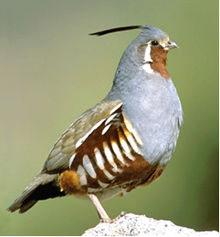- Mountain Quail
-
Mountain Quail 
male Conservation status Scientific classification Kingdom: Animalia Phylum: Chordata Class: Aves Subclass: Neornithes Infraclass: Neognatha Superorder: Galloanserae Order: Galliformes Family: Odontophoridae Genus: Oreortyx
Baird, 1858Species: O. pictus Binomial name Oreortyx pictus
(Douglas, 1829)The Mountain Quail, (Oreortyx pictus), is a small ground-dwelling bird in the New World quail family. This species is the only one in the genus Oreortyx, which is sometimes included in Callipepla. This is not appropriate, however, as the Mountain Quail's ancestors have diverged from other New World quails earlier than the bobwhites, no later than 6 mya[1].
Contents
Description
The bird's average length is 26-28 cm, with a wingspan of 35-40 cm. They have relatively short, rounded wings and long, featherless legs. These birds are easily recognized by their top knots, which are shorter in the female. They have a brown face, gray breast, brown back and primaries, and heavily white barred underside.
Taxonomy
Subspecies
There are five recognized subspecies:
- O. p. confinis (Anthony, 1889) - Southern Mountain Quail - mountains of northern Baja California
- O. p. eremophilus (Van Rossem, 1937) - Desert Mountain Quail - Sierra Nevada of southern California to northern Baja, and extreme southwestern Nevada
- O. p. pictus (Douglas, 1829) - nominate - Cascade Range of Washington to coastal mountains of central California
- O. p. plumifer (Gould, 1837) - southern Washington to western Nevada and central California
- O. p. russelli (AH Miller, 1946) - Pallid Mountain Quail - Little San Bernardino Mountains of southern California
Distribution and habitat
It inhabits mountainous chapparal west of the Rocky Mountains, from the United States to Baja peninsula Mexico. It has been introduced to British Columbia in Canada, and some areas of Washington state in the USA. It can be found up to 3000 m above sea level. It is a non-migratory species; however some populations may be altitudinal migrants in some mountain ranges.
Behaviour
Mountain Quail primarily move about by walking, and can move surprisingly quickly through brush and undergrowth. In the late summer, fall and winter, the adults and immature young congregate into family groups of up to 20 birds. The birds habits can be secretive. Any flight is usually short and explosive, with many rapid wingbeats followed by a slow glide to the ground.
Feeding
Its diet consists primarily of plant matter and seeds. The chicks are decidedly more insectivorous than adults, gradually consuming more plant matter as they mature.
Breeding
Breeding among Mountain Quail is monogamous, and rarely gregarious. The female typically lays 9-10 eggs in a simple scrape concealed in vegetation, often at the base of a tree or shrub, usually close to water. Incubation lasts from 21-25 days, usually performed by the female and rarely by the male. The chicks are precocial, leaving the nest with their parents within hours of hatching.
Status and conservation
It is not considered threatened by the IUCN, being plentiful across a wide range. However, its success is tied to sufficient habitat, which expands in cooler and more arid climate. Subfossil remains have been found, for example at Rocky Arroyo in the Guadalupe Mountains and Shelter Cave, New Mexico, where today not enough habitat exists anymore. The bones date found from the end of the last ice age to not much more than 8000 BC[2].
Footnotes
References
- BirdLife International (2004). Oreortyx pictus. 2006. IUCN Red List of Threatened Species. IUCN 2006. www.iucnredlist.org. Retrieved on 11 May 2006. Database entry includes justification for why this species is of least concern
- Carroll, John P. (1994): 4. Mountain Quail. In: del Hoyo, Josep; Elliott, Andrew & Sargatal, Jordi (eds.): Handbook of Birds of the World, Volume 2 (New World Vultures to Guineafow): 423, plate 39. Lynx Edicions, Barcelona. ISBN 84-87334-15-6
- National Geographic Society (2002): Field Guide to the Birds of North America. National Geographic, Washington DC. ISBN 0-792-26877-6
- Sibley, David Allen (2000): The Sibley Guide to Birds. Alfred A. Knopf, New York. ISBN 0-679-45122-6
- Zink, Robert M. & Blackwell, Rachelle C. (1998): Molecular systematics of the Scaled Quail complex (genus Callipepla). Auk 115 (2): 394-403. PDF fulltext
External links
- Mountain Quail videos on the Internet Bird Collection
- Mountain Quail photo gallery
- Quail Home Page
Categories:- IUCN Red List least concern species
- Odontophoridae
- Quails
- Birds of the United States
- Birds of Canada
- Birds of Mexico
- Fauna of the California chaparral and woodlands
- Monotypic bird genera
- Animals described in 1829
Wikimedia Foundation. 2010.


